How to remove highlevelnetwork.co.in notifications (ads)
Notification SpamAlso Known As: Ads by highlevelnetwork.co.in
Get free scan and check if your device is infected.
Remove it nowTo use full-featured product, you have to purchase a license for Combo Cleaner. Seven days free trial available. Combo Cleaner is owned and operated by RCS LT, the parent company of PCRisk.com.
What kind of page is highlevelnetwork.co[.]in?
Highlevelnetwork.co[.]in is a rogue webpage discovered by our researchers during a routine investigation of suspicious sites. Upon inspection, we learned that this page endorses browser notification spam and produces redirects to other (likely unreliable/dangerous) websites.
The majority of users access webpages like highlevelnetwork.co[.]in via redirects caused by websites employing rogue advertising networks.
![highlevelnetwork.co[.]in pop-up redirects](/images/stories/screenshots202503/highlevelnetwork-co-in-website-main.jpg)
Highlevelnetwork.co[.]in overview
It has to be mentioned that the behavior of rogue webpages might vary based on the visitor's IP address (geolocation). In other words, this information may dictate the content encountered on and through these sites.
When we entered highlevelnetwork.co[.]in, it presented us with a blurred page similar in appearance to a news website. The pop-up in the middle of the page was a checkbox-type CAPTCHA test. Upon its completion, the page was darkened and displayed instructions to – "Click 'Allow' to confirm you are not a robot".
The CAPTCHA verification on highlevelnetwork.co[.]in is fake, and the "Allow" button serves as the consent option to the webpage's browser notification delivery.
Rogue websites use their notifications to run intrusive advert campaigns. These ads can endorse online scams, untrustworthy/hazardous software, and malware.
To summarize, through pages like highlevelnetwork.co[.]in – users may experience system infections, serious privacy issues, financial losses, and even identity theft.
| Name | Ads by highlevelnetwork.co.in |
| Threat Type | Push notifications ads, Unwanted ads, Pop-up ads |
| Detection Names | Seclookup (Malicious), Sophos (Spam), Full List Of Detections (VirusTotal) |
| Serving IP Address | 108.62.60.42 |
| Observed Domains | cv7ebmohubcc73a2tqk0.highlevelnetwork.co[.]in; curm1f0hubcc73dhe390.highlevelnetwork.co[.]in; cus0bdohubcc73dsqgu0.highlevelnetwork.co[.]in; cv1n6s0hubcc73fnt18g.highlevelnetwork.co[.]in; cv35p10hubcc739cu5g0.highlevelnetwork.co[.]in; cv4s0f8hubcc73bcff30.highlevelnetwork.co[.]in; cv5g2ighubcc73c8nm50.highlevelnetwork.co[.]in; cv5h1aghubcc73ca0jng.highlevelnetwork.co[.]in; cv7ect8hubcc73a2v2r0.highlevelnetwork.co[.]in; cv8hanohubcc73bd1ju0.highlevelnetwork.co[.]in; pc.highlevelnetwork.co[.]in. |
| Symptoms | Seeing advertisements not originating from the sites you are browsing. Intrusive pop-up ads. Decreased Internet browsing speed. |
| Distribution Methods | Deceptive pop-up ads, false claims within visited websites, potentially unwanted applications (adware) |
| Damage | Decreased computer performance, browser tracking - privacy issues, possible additional malware infections. |
| Malware Removal (Windows) |
To eliminate possible malware infections, scan your computer with legitimate antivirus software. Our security researchers recommend using Combo Cleaner. Download Combo CleanerTo use full-featured product, you have to purchase a license for Combo Cleaner. 7 days free trial available. Combo Cleaner is owned and operated by RCS LT, the parent company of PCRisk.com. |
Browser notification spam in general
Bedoq[.]info, cqwyjj[.]click, sayadsleads[.]top, vfirewall[.]pro, and irlitathal[.]com are just some of our latest articles on rogue pages.
These websites deliver browser notification that endorse deceptive and malicious material. Keep in mind that any genuine content encountered via these advertisements is most likely promoted by scammers who abuse its affiliate programs to obtain illegitimate commissions.
How did highlevelnetwork.co[.]in gain permission to deliver spam notifications?
Websites need user permission to deliver browser notifications. Therefore, if you are seeing these ads from highlevelnetwork.co[.]in – it means that when this page was entered, consent to their delivery was granted by clicking "Allow", "Allow Notifications", or an analogous option.
It is noteworthy that rogue sites commonly use various lures (e.g., fake CAPTCHA verification tests, explicit adult-oriented content, clickbait, etc.) to trick visitors into enabling notifications.
How to prevent deceptive sites from delivering spam notifications?
To avoid receiving undesirable browser notifications – do not permit suspect sites to deliver them (i.e., do not click "Allow", "Allow Notifications", etc.). We advise denying notification delivery from such webpages (i.e., selecting "Block", "Block Notifications", etc.) or ignoring these requests in their entirety.
In case of continuous random redirects to dubious websites, check the browser and system for installed advertising-supported software (adware). If your computer is already infected with rogue applications, we recommend running a scan with Combo Cleaner Antivirus for Windows to automatically eliminate them.
Screenshot of a notification (advertisement) displayed by the highlevelnetwork.co[.]in website:
![Ad delivered by the highlevelnetwork.co[.]in webpage](/images/stories/screenshots202503/highlevelnetwork-co-in-website-delivered-ad.jpg)
Appearance of the highlevelnetwork.co[.]in website (GIF):
![highlevelnetwork.co[.]in website appearance (GIF)](/images/stories/screenshots202503/highlevelnetwork-co-in-website-appearance.gif)
Instant automatic malware removal:
Manual threat removal might be a lengthy and complicated process that requires advanced IT skills. Combo Cleaner is a professional automatic malware removal tool that is recommended to get rid of malware. Download it by clicking the button below:
DOWNLOAD Combo CleanerBy downloading any software listed on this website you agree to our Privacy Policy and Terms of Use. To use full-featured product, you have to purchase a license for Combo Cleaner. 7 days free trial available. Combo Cleaner is owned and operated by RCS LT, the parent company of PCRisk.com.
Quick menu:
- What is Ads by highlevelnetwork.co.in?
- STEP 1. Remove spam notifications from Google Chrome
- STEP 2. Remove spam notifications from Google Chrome (Android)
- STEP 3. Remove spam notifications from Mozilla Firefox
- STEP 4. Remove spam notifications from Microsoft Edge
- STEP 5. Remove spam notifications from Safari (macOS)
Disable unwanted browser notifications:
Video showing how to disable web browser notifications:
 Remove spam notifications from Google Chrome:
Remove spam notifications from Google Chrome:
Click the Menu button (three dots) on the right upper corner of the screen and select "Settings". In the opened window select "Privacy and security", then click on "Site Settings" and choose "Notifications".
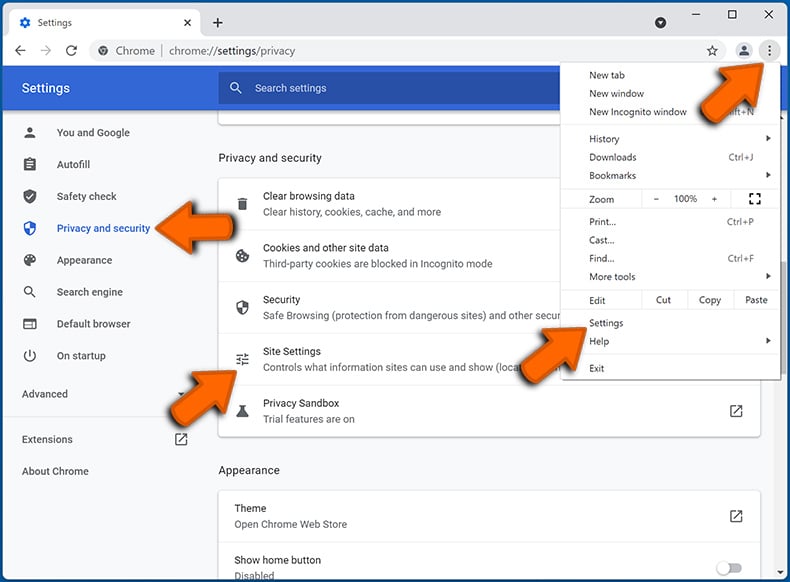
In the "Allowed to send notifications" list search for websites that you want to stop receiving notifications from. Click on the three dots icon near the website URL and click "Block" or "Remove" (if you click "Remove" and visit the malicious site once more, it will ask to enable notifications again).
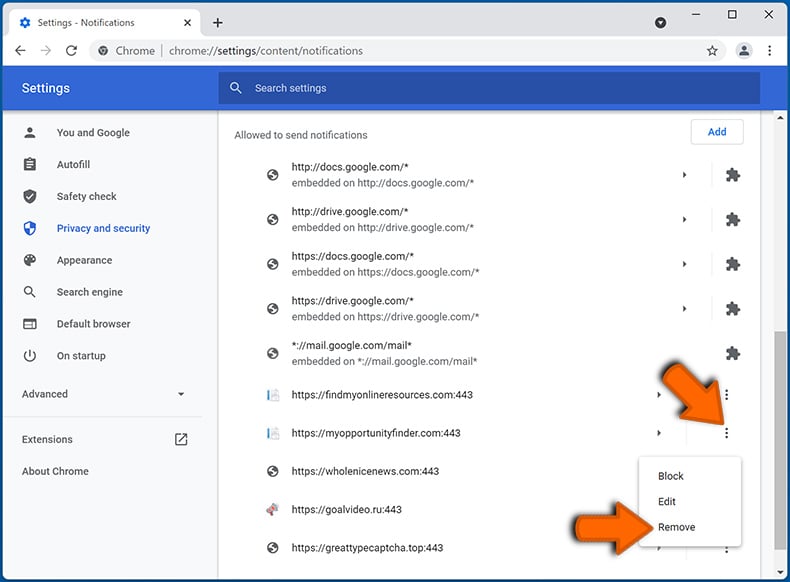
 Remove spam notifications from Google Chrome (Android):
Remove spam notifications from Google Chrome (Android):
Tap the Menu button (three dots) on the right upper corner of the screen and select "Settings". Scroll down, tap on "Site settings" and then "Notifications".
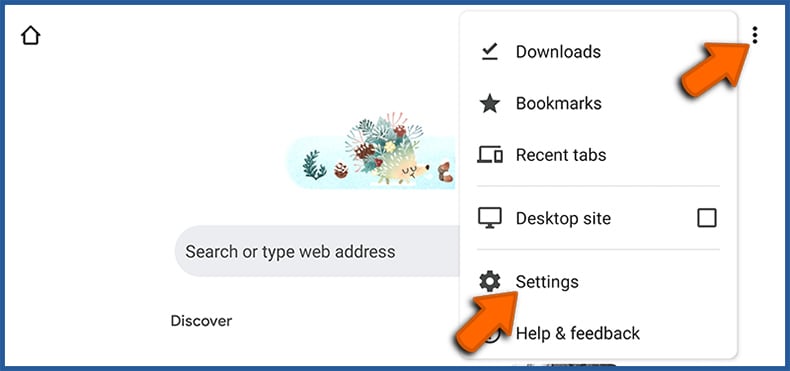
In the opened window, locate all suspicious URLs and tap on them one-by-one. Once the pop-up shows up, select either "Block" or "Remove" (if you tap "Remove" and visit the malicious site once more, it will ask to enable notifications again).
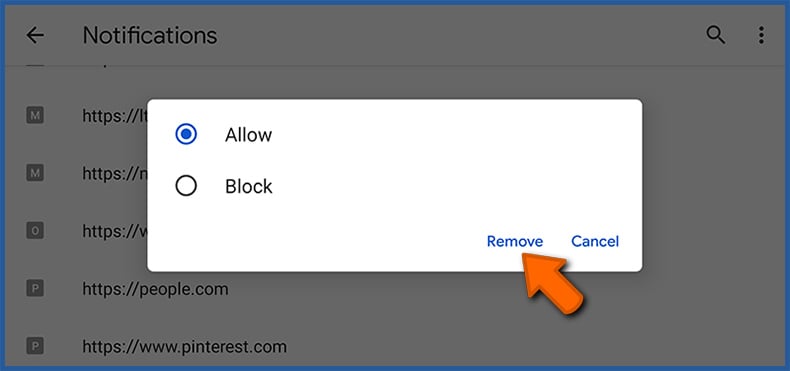
 Remove spam notifications from Mozilla Firefox:
Remove spam notifications from Mozilla Firefox:
Click the Menu button (three bars) on the right upper corner of the screen. Select "Settings" and click on "Privacy & Security" in the toolbar on the left hand side of the screen. Scroll down to the "Permissions" section and click the "Settings" button next to "Notifications".
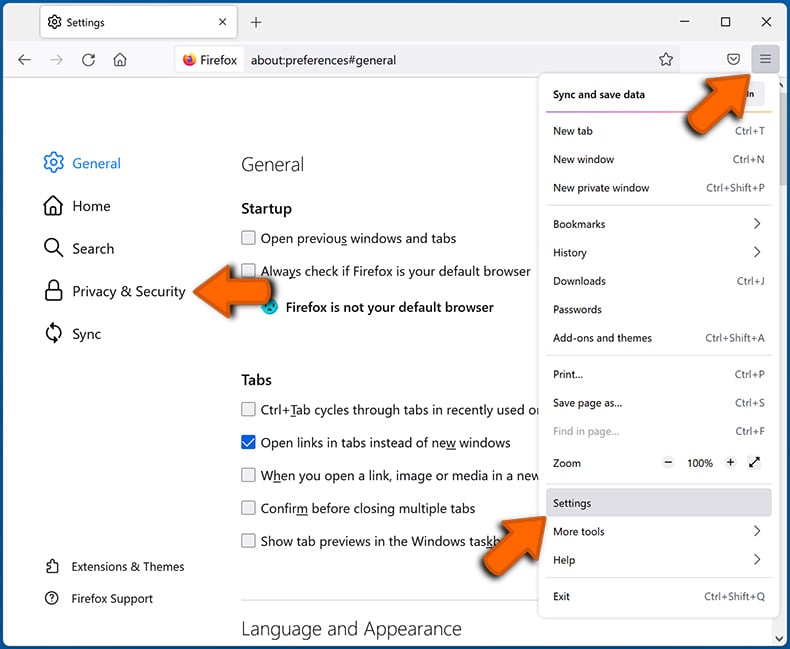
In the opened window, locate all suspicious URLs and block them using the drop-down menu or either remove them by clicking "Remove Website" at the bottom of the window (if you click "Remove Website" and visit the malicious site once more, it will ask to enable notifications again).
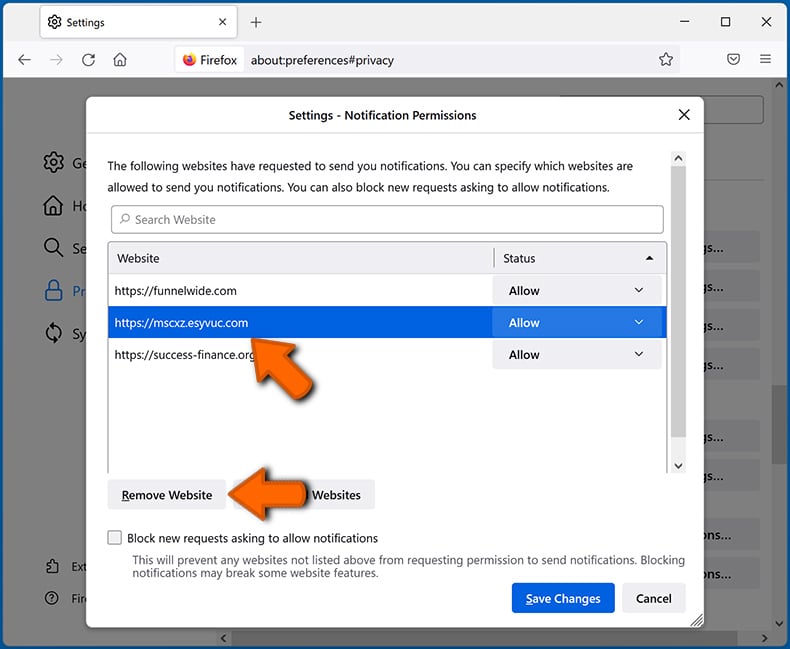
 Remove spam notifications from Microsoft Edge:
Remove spam notifications from Microsoft Edge:
Click the menu button (three dots) on the right upper corner of the Edge window and select "Settings". Click on "Cookies and site permissions" in the toolbar on the left hand side of the screen and select "Notifications".
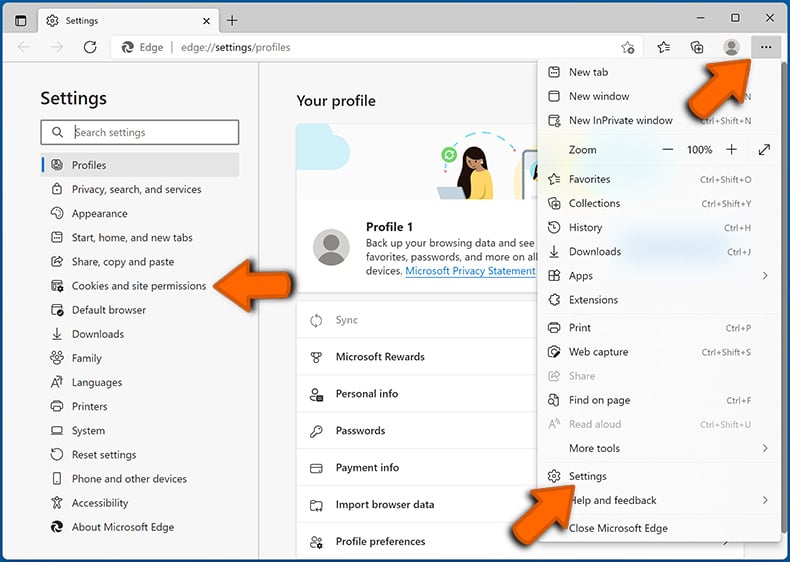
Click three dots on the right hand side of each suspicious URL under "Allow" section and click "Block" or "Remove" (if you click "Remove" and visit the malicious site once more, it will ask to enable notifications again).
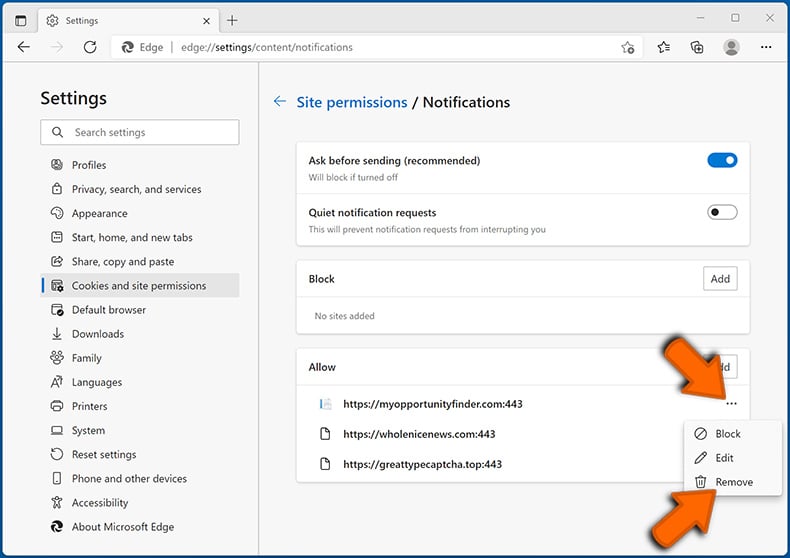
 Remove spam notifications from Safari (macOS):
Remove spam notifications from Safari (macOS):
Click "Safari" button on the left upper corner of the screen and select "Preferences...". Select the "Websites" tab and then select "Notifications" section on the left pane.
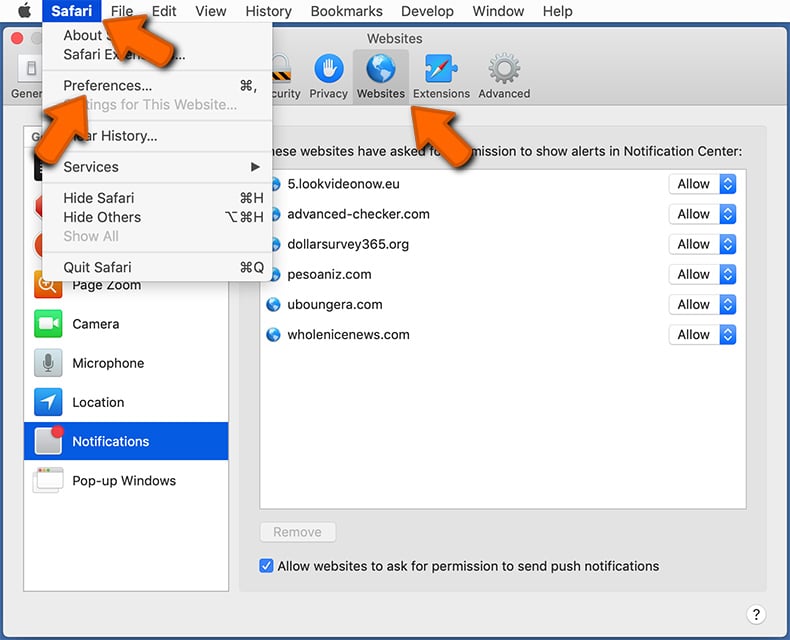
Check for suspicious URLs and apply the "Deny" option using the drop-down menu or either remove them by clicking "Remove" at the bottom of the window (if you click "Remove" and visit the malicious site once more, it will ask to enable notifications again)
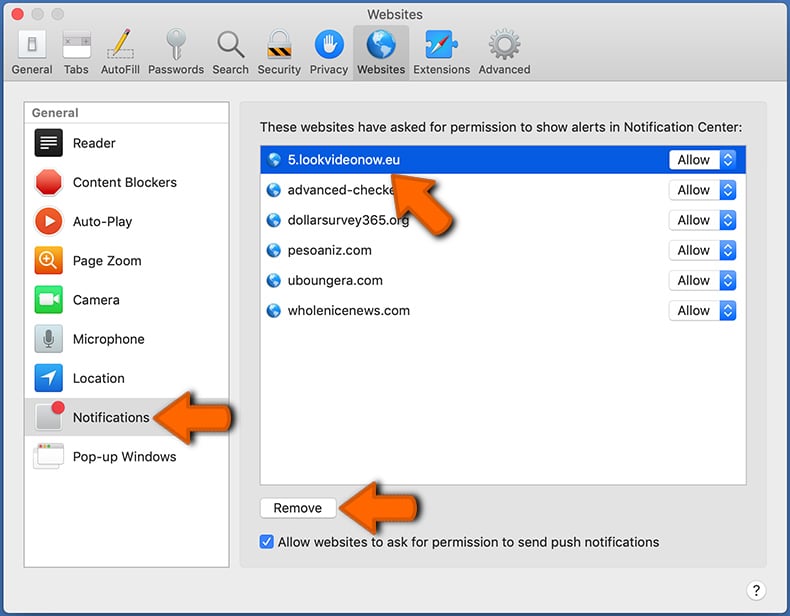
How to avoid browser notification spam?
Internet users should be very skeptical when being asked to allow notifications. While this is a useful feature that allows you to receive timely news from websites you like, deceptive marketers frequently abuse it.
Only allow notifications from websites that you fully trust. For added security - use an anti-malware application with a real-time web browsing monitor to block shady websites that tries to trick you into allowing spam notifications. We recommend using Combo Cleaner Antivirus for Windows.
Frequently Asked Questions (FAQ)
Why am I seeing ads (browser notifications) delivered by highlevelnetwork.co[.]in in the right lower corner of my desktop?
User consent is necessary for any site to deliver browser notifications (ads). Therefore, you have likely accessed highlevelnetwork.co[.]in and clicked "Allow", "Allow Notifications", or a similar option.
I have clicked on notification ads, is my computer infected?
No, merely clicking on a browser notification does not pose an infection threat. However, these advertisements can promote content that does.
Is highlevelnetwork.co[.]in a virus?
No, websites like highlevelnetwork.co[.]in are not considered to be viruses, even though they can endorse virulent content. Rogue webpages often promote online scams, unreliable/harmful software, and even malware.
Will Combo Cleaner remove highlevelnetwork.co[.]in ads automatically or manual steps are still required?
Yes, Combo Cleaner can scan devices and undo the permissions given to the highlevelnetwork.co[.]in page. Additionally, it can restrict all further access to this and other rogue, deceptive, and malicious websites. Therefore, no extra steps will be necessary.
Share:

Tomas Meskauskas
Expert security researcher, professional malware analyst
I am passionate about computer security and technology. I have an experience of over 10 years working in various companies related to computer technical issue solving and Internet security. I have been working as an author and editor for pcrisk.com since 2010. Follow me on Twitter and LinkedIn to stay informed about the latest online security threats.
PCrisk security portal is brought by a company RCS LT.
Joined forces of security researchers help educate computer users about the latest online security threats. More information about the company RCS LT.
Our malware removal guides are free. However, if you want to support us you can send us a donation.
DonatePCrisk security portal is brought by a company RCS LT.
Joined forces of security researchers help educate computer users about the latest online security threats. More information about the company RCS LT.
Our malware removal guides are free. However, if you want to support us you can send us a donation.
Donate
▼ Show Discussion